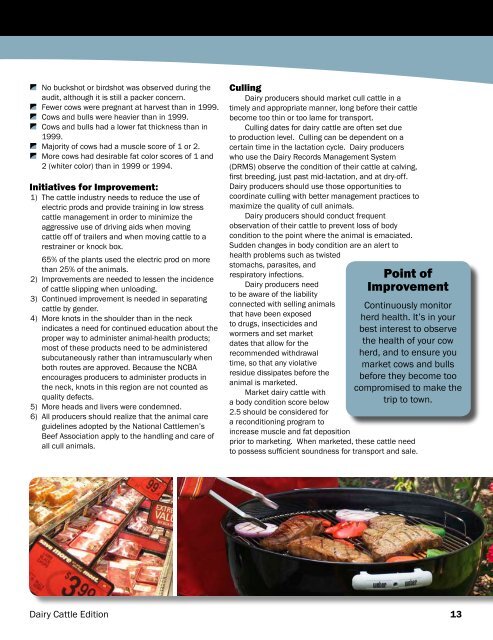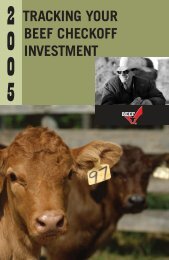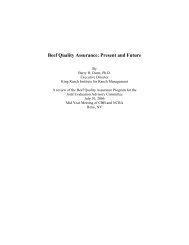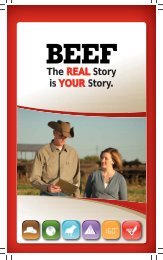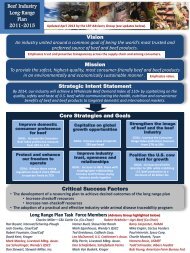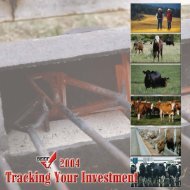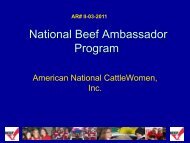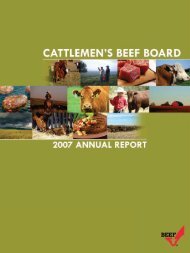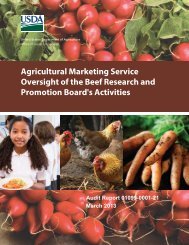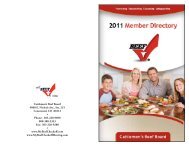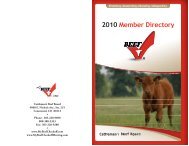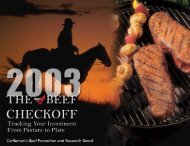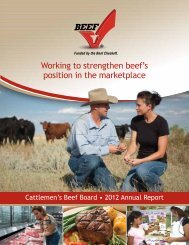Point ofImprovementEnsure the safety of yourproduct. <strong>Cow</strong>s <strong>and</strong> bullsmust be free of chemical,pathogenic <strong>and</strong> physicalhazards when you shipthem for harvest.Phase III – End User <strong>Audit</strong>s –A total of eight end-user audits were conducted.These audits consisted of interviews <strong>and</strong> lookingfor quality defects in subprimal cuts as they werebeing further processed. <strong>Audit</strong>ors looked at topsirloin center-cuts, <strong>and</strong> caps, <strong>and</strong> bottom round flats.They looked for any injection site lesions as well asother defects that cause devaluation.Top 5 cow <strong>and</strong> bull quality challenges accordingto end users as determined during theinterview process –Product uniformityProduct qualityBuck shot<strong>Cattle</strong> availabilityInjection sitesTop 5 improvements incow/bull subprimals – Endusers said that overall injectionrelateddefects (beef <strong>and</strong> dairycarcasses) have improved since1999, including a reductionin the incidence of needles,abscesses, injection site lesions,<strong>and</strong> bruising. They also noted thatthere were fewer incidences ofbuckshot.Declines in cow/bullsubprimals since 1999 – Endusers noted growing concerns overmeat from subprimals that is too light or too dark incolor. Coloration problems were mainly a concern forsteaks cut from top butts.Top sirloin cap defects – When examining thesubprimals as they were being further processed,end-user auditors found that 9.4% of top sirloincaps had injection site blemishes. 90.0% of dairytop sirloin caps had no defects. 8.0% had minordefects, 0.1% had severe defects, <strong>and</strong> 0.2% werecondemned.Top sirloin center cut defects – 95.8% of allcenter cuts had no defects. 3.8% of center cuts hadinjection-site blemishes.Bottom round defects – 67.0% of all bottomrounds had no defects. 10.4 % had active lesions,15.5 % had woody calluses, 3.6% had fibrous scars,1.0% had bruises, <strong>and</strong> 2.7% were dark cutters. In1999, 57.5% of dairy flats had defects, compared to59.1% in 2007. 25.3% had minor defects, 1.3% hadsevere defects, <strong>and</strong> 0.1% were condemned.Conclusions – The Strategy WorkshopRepresentatives of all industry sectorsmet at a strategy workshop to discuss findingsof the audit, <strong>and</strong> to develop industry-widerecommendations for the improvement of qualitydefects in cows <strong>and</strong> bulls.Overall, participants agreed, the dairy cattleindustry has made significant quality gains since thelast audit.There has been significant improvement in thereduction of downer cattle.All trailer <strong>and</strong> truck loads met the American MeatInstitute guidelines for spacing.Less than 1% of the cattle traveled for more than28 hours.Fewer cattle had mud/manure problems than in1999.More cattle were polled than in 1999.“The reduction in the incidence of horns is apositive development because horns can causesubstantial bruising to other animals in pens <strong>and</strong> ontrucks,” says Lynn Delmore, California PolytechnicState University. “Horns can also result in headcondemnations during postmortem inspectionsbecause they have to be removed to allow the hide tobe removed properly. This exposes the sinus cavity tohair <strong>and</strong> other foreign materials that violate the zerotolerance st<strong>and</strong>ards.”More cattle had no br<strong>and</strong>s than in 1999. Thepresence of br<strong>and</strong>s causes devaluation of hides,particularly if the br<strong>and</strong> is located on the ribs.92% of the cattle in the 2007 audit had ID(predominantly back tags), so traceability wasimproved.The majority of dairy cattle were Holsteins.97% of the cattle had no evidence of cancer eye(an improvement over 1999 <strong>and</strong> 1994).More dairy <strong>and</strong> beef cows were in leanercondition.Fewer cattle had inadequate muscle scores.Fewer cattle had bruises than in 1994 <strong>and</strong> 1999.This is a positive trend because bruises requiretrimming in varying degrees depending on theseverity of the bruise.Overall 94% of the cattle had no evidence ofinjection-site blemishes, but 11% of dairy cowshad visible injection-site blemishes.Fewer cattle had arthritic joints than in 1999.This is a very positive trend because packersare required to remove all tissue associated witharthritic stifle joints. Fewer arthritic joints equalless trim loss.12 <strong>National</strong> <strong>Market</strong> <strong>Cow</strong> <strong>and</strong> <strong>Bull</strong> <strong>Beef</strong> <strong>Quality</strong> <strong>Audit</strong>
No buckshot or birdshot was observed during theaudit, although it is still a packer concern.Fewer cows were pregnant at harvest than in 1999.<strong>Cow</strong>s <strong>and</strong> bulls were heavier than in 1999.<strong>Cow</strong>s <strong>and</strong> bulls had a lower fat thickness than in1999.Majority of cows had a muscle score of 1 or 2.More cows had desirable fat color scores of 1 <strong>and</strong>2 (whiter color) than in 1999 or 1994.Initiatives for Improvement:1) The cattle industry needs to reduce the use ofelectric prods <strong>and</strong> provide training in low stresscattle management in order to minimize theaggressive use of driving aids when movingcattle off of trailers <strong>and</strong> when moving cattle to arestrainer or knock box.65% of the plants used the electric prod on morethan 25% of the animals.2) Improvements are needed to lessen the incidenceof cattle slipping when unloading.3) Continued improvement is needed in separatingcattle by gender.4) More knots in the shoulder than in the neckindicates a need for continued education about theproper way to administer animal-health products;most of these products need to be administeredsubcutaneously rather than intramuscularly whenboth routes are approved. Because the NCBAencourages producers to administer products inthe neck, knots in this region are not counted asquality defects.5) More heads <strong>and</strong> livers were condemned.6) All producers should realize that the animal careguidelines adopted by the <strong>National</strong> <strong>Cattle</strong>men’s<strong>Beef</strong> Association apply to the h<strong>and</strong>ling <strong>and</strong> care ofall cull animals.Culling<strong>Dairy</strong> producers should market cull cattle in atimely <strong>and</strong> appropriate manner, long before their cattlebecome too thin or too lame for transport.Culling dates for dairy cattle are often set dueto production level. Culling can be dependent on acertain time in the lactation cycle. <strong>Dairy</strong> producerswho use the <strong>Dairy</strong> Records Management System(DRMS) observe the condition of their cattle at calving,first breeding, just past mid-lactation, <strong>and</strong> at dry-off.<strong>Dairy</strong> producers should use those opportunities tocoordinate culling with better management practices tomaximize the quality of cull animals.<strong>Dairy</strong> producers should conduct frequentobservation of their cattle to prevent loss of bodycondition to the point where the animal is emaciated.Sudden changes in body condition are an alert tohealth problems such as twistedstomachs, parasites, <strong>and</strong>respiratory infections.<strong>Dairy</strong> producers needto be aware of the liabilityconnected with selling animalsthat have been exposedto drugs, insecticides <strong>and</strong>wormers <strong>and</strong> set marketdates that allow for therecommended withdrawaltime, so that any violativeresidue dissipates before theanimal is marketed.<strong>Market</strong> dairy cattle witha body condition score below2.5 should be considered fora reconditioning program toincrease muscle <strong>and</strong> fat depositionprior to marketing. When marketed, these cattle needto possess sufficient soundness for transport <strong>and</strong> sale.Point ofImprovementContinuously monitorherd health. It’s in yourbest interest to observethe health of your cowherd, <strong>and</strong> to ensure youmarket cows <strong>and</strong> bullsbefore they become toocompromised to make thetrip to town.<strong>Dairy</strong> <strong>Cattle</strong> <strong>Edition</strong> 13


